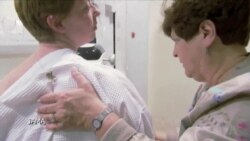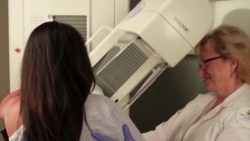Breast cancer is the most common cancer in women worldwide.
Early discovery and treatment can save lives.
Scientists are working new ways to recognize breast cancer while at the same time studying existing methods of identification to find out what is best.
Take mammograms, for example. During the test, a technician takes an X-ray picture of a woman’s breast as it is pressed between two glass plates. A radiologist then examines the image for signs of cancer.
Mammograms are the best tools available for recognizing the disease. The number of breast cancer deaths has fallen by 30 percent in the United States since doctors began offering mammography in the 1970s. The reason: the chances of beating cancer are higher when the disease is found early.
Yet mammograms are not perfect. A mammogram can look normal even when cancer is present. It can also look abnormal, or unusual, when cancer is not present.
Traditional mammograms are two dimensional (2-D). They show length and width. But for the 40 to 50 percent of women with dense breasts, it is difficult for radiologists to see cancer on 2-D images.
Three-dimensional mammograms provide a more detailed look. So women with dense breasts may get better results from a 3-D mammogram, said Otis Brawley of the American Cancer Society.
“It might find disease that we need to find that two-dimensional does not,” Brawley said. He added that 3-D testing costs more and involves higher levels of radiation. It also is not 100 % perfect, he said.
Cost aside, one study involving 13 U.S. hospitals showed that 3-D mammograms recognized an additional 40 percent of invasive cancers.
For better results, a woman could have a whole-breast ultrasound. This test requires the patient to lie on her back as the ultrasound device slowly moves back and forth. The exam captures between 3,000 and 5,000 images of the breast.
Megha Garg is the director of the breast-imaging program at the University of Missouri cancer center. She says the whole-breast ultrasound “helps detect additional breast cancers in females who have dense breasts.”
The ultrasound doesn’t use radiation, so it is less risky than a mammogram. But Garg says the traditional mammogram remains a helpful tool because it is very effective.
Researchers are studying which method is best at detecting cancer.
North America, Western Europe and Australia have the highest rates of breast cancer. Yet the World Health Organization reports that almost 50 percent of the cases and nearly 60 percent of the deaths happen in less-developed countries.
With improvements, nearly 400,000 women’s lives could be saved every year.
I'm Susan Shand.
Carol Pearson reported this story for VOA. Susan Shand adapted her story for Learning English.
______________________________________________________________
Words in This Story
mammogram – n. a photograph of a woman's breasts made by X-rays
radiologist – n. a doctor who is trained in the branch of medicine that uses some forms of radiation (such as X-rays) to diagnose and treat diseases
dimensional – adj. the length, width, height, or depth of something
dense – adj. having parts that are close together
ultrasound – n. a method of producing images of the inside of the body by using a machine that produces sound waves which are too high to be heard








